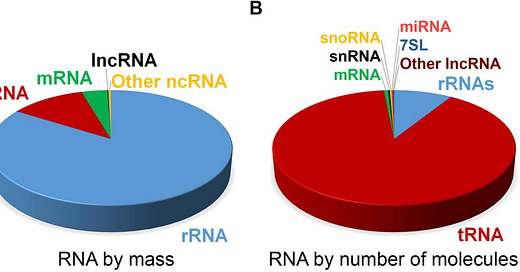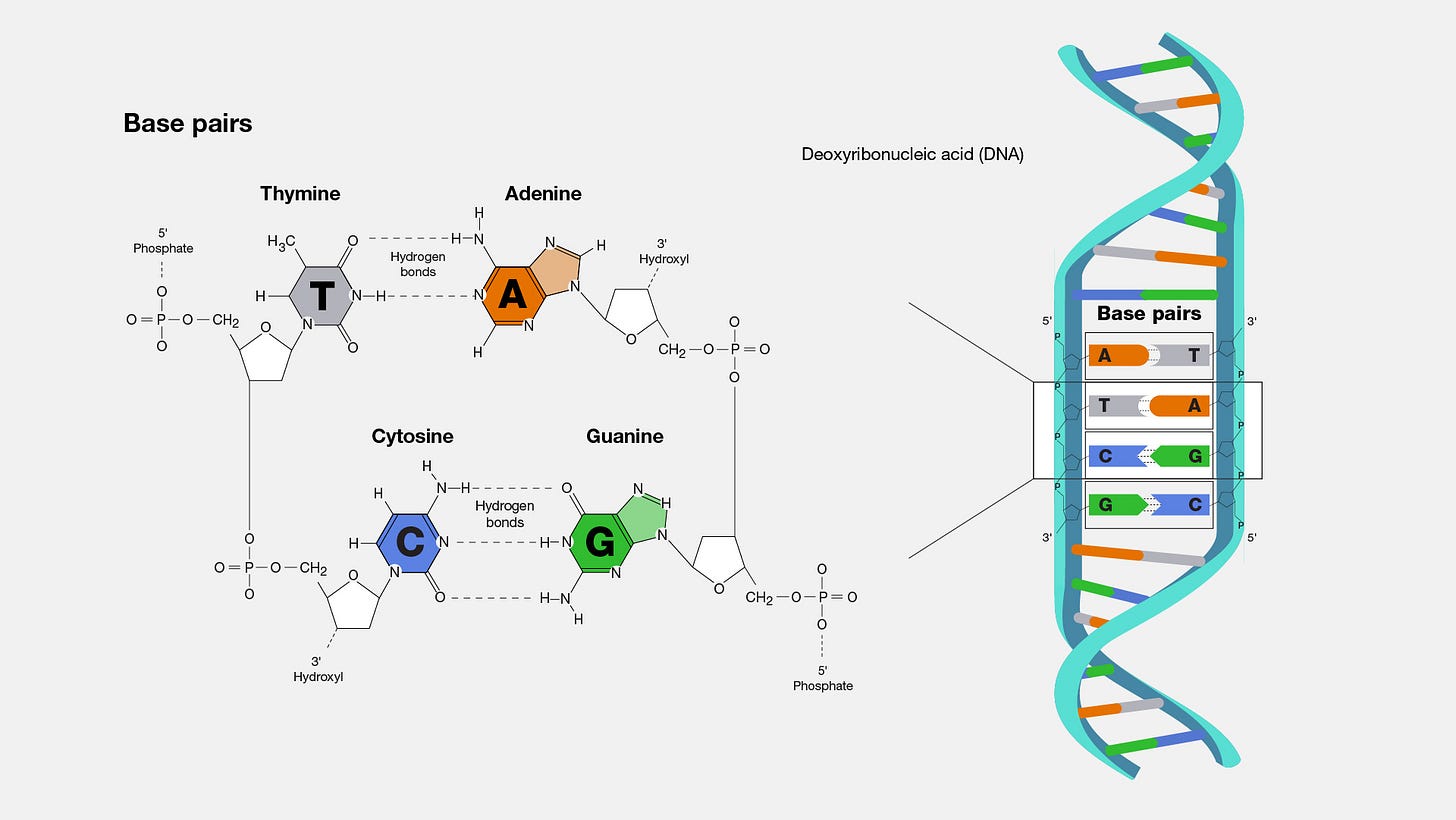Here’s a question that we should have answered before rolling out mRNA vaccines to billions of people:
Can they interfere with a cell’s natural RNA?
Types of RNA in the cell
Cells naturally contain many different types of RNA. Some are in the form of mRNA, or messenger RNA, otherwise known as “transcripts.” These get translated into proteins; they “code” for proteins.
There is also “non-coding RNA” which refers to RNA that does not get translated into protein. There are different types of non-coding RNA, and we don’t understand what all of them do. Some may be familiar to you, like transfer RNA and ribosomal RNA, but others have only been recently discovered.

There’s a debate over what percentage of noncoding RNAs are functional. Some researchers think that all of them have functions within the cell, while others think that at least some of them serve no function.
Can mRNA vaccines interfere with RNA in the cell?
When a cell takes up mRNA vaccine, it has taken up (“is transfected with”) single stranded mRNA that could potentially interact with other RNAs in the cell.
Specifically the mRNA can pair up with other pieces of single stranded RNA that happen to have complementary base pairs. This is sometimes called “Watson-Crick nucleotide sequence complementarity.”
The image below illustrates this with DNA, but a similar process can happen with RNA:
The image shows how two single strands with complementary sequences can form base pairs to form double stranded DNA. The “bases” in DNA are thymine, adenine, cytosine, and guanine. Thymine (T) base pairs with adenine (A) and cytosine (C) pairs with guanine (G).
With RNA, the thymine is replaced with uridine, and the uridine base pairs with adenine. So if you have an RNA sequence of UAGC, it can form base pairs with a strand of RNA that has AUCG. This would result in double stranded RNA, which triggers a process in the cell called “RNA silencing.” This process looks for and degrades double stranded RNA; our cells probably do this as a defense against viruses that have double stranded RNA.
Now, how would we know if inserting foreign mRNA, like mRNA vaccine, interferes with a cell’s natural RNA?
We would need to have an idea of the possible RNA sequences present in our cells. Luckily, there are databases with that kind of information, so one could search them for sequences that are complementary to the mRNA vaccine.
What a study did
One researcher did just that: COVID-19 mRNA vaccines as hypothetical epigenetic players: Results from an in silico analysis, considerations and perspectives
They searched for human coding or noncoding sequences that could pair with the Pfizer COVID-19 mRNA vaccine (BNT162b2).
This kind of search is often called an “alignment.” There are different algorithms for performing alignments, like BLAST (basic local alignment search tool) or BLAT (BLAST-like alignment tool), which is a variation of BLAST.
You can even play around with this yourself. The sequence for the Pfizer vaccine is at the end of the document here. You’ll notice that the sequence contains the normal G, C, and A, but instead of U it has “Ψ.” That’s because in the vaccine they replaced all uridines with something called “N1-methylpseudouridine.” In order to do any kind of alignment you have to first replace all instances of “Ψ” with “U.”
Then copy that sequence and paste it into here in the box that says “Enter Query Sequence.” Then click “BLAST” near the bottom.
There are some parameters that one could play around with when doing a BLAST (see here), but this is what the process looks like in its most basic form.
By the way, “BLASTN” is just a kind of BLAST program that is specifically for comparing nucleotide sequences with other nucleotide sequences; this is just to differentiate it from other things you can do with BLAST, like comparing two proteins (BLASTP), etc.
The results
So what do we find if we run this kind of search with the Pfizer vax?
BNT162b2 mRNA matched 19 human genes whose protein products are variously involved in enzyme reactions, nucleotide or cation binding, signaling, and carrier functions.
In other words, the vax mRNA could potentially interfere with the expression of 19 human genes.
They found that the vax mRNA aligned with some noncoding RNAs (ncRNAs) as well:
BLASTN analysis against human ncRNA genes revealed 17 hits to BNT162b2 mRNA, Supplementary Table 2. Specifically, BNT162b2 mRNA showed sequence homology to 1 mitochondrial ribosomal RNA (mt rRNA) and 16 long noncoding (lnc) RNA genes
Again, recall that the functions of a lot of noncoding RNAs are not well understood. 16 of the hits were to “long non-coding RNA”; these are long RNAs that are not translated to protein and may be involved in gene regulation.
In 5 cases, hits fell in regulatory regions of human lncRNA genes (2 promoters and 3 promoter flanks), whose nearby protein coding genes inhibit anabolic or pro-inflammatory pathways, control the mitochondrial respiratory chain, or preside over lipid metabolism.
Translations: “anabolic” refers to any process that builds up complex molecules from simpler molecules; it’s the opposite of a “catabolic” process which breaks down complex molecules into simpler molecules, like when you break down food. The “mitochondrial respiratory chain” consists of several enzymes that are key for the function of mitochondria, which produce ATP, otherwise known as the energy currency of the cell. The main point here is that the vax mRNA could mess with the regulation of some very important processes.
And:
In addition, 12 of the 17 BNT162b2 mRNA-complementary transcripts were found to interact with histone modifications (H3K27me3, H3K4me1, and H3K4me3) that typically characterize eRNAs [21,43]. eRNAs are synthesized from lncRNAs and are normally neither spliced nor polyadenylated [44]. By recruiting RNA polymerase II and other proteins to promoter sites, they epigenetically control transcription of distal genes. Although present in low copy numbers, a deficiency of eRNAs can strongly affect the transcription of protein-coding genes, including those involved in cellular differentiation. Their expression is increased in human cancer tissues [45,46], and eRNAs can lead to both genetic mutations and epigenetic dysregulations, which in turn defectively regulate the expression of oncogenes or tumor suppressor genes [46]. To date, it is unknown whether administration of COVID-19 mRNA vaccines poses an actual risk of carcinogenesis.
Translations: “histones” are proteins that help wind up DNA into compact structures. “Histone modifications” can affect how specific segments of DNA are coiled, which affect how accessible the genes in those segments are, and therefore affect how those genes are expressed. “eRNAs” are enhancer RNAs, which is another type of non-coding RNA that may be involved in helping to regulate gene expression.
The paper also acknowledges that the vaccine is not going to stay at the injection site, near the muscles:
Moreover, the biodistribution of vaccine mRNA in human tissues, including the amount taken up by skeletal muscle, is hazardous given the lack of tissue specificity of these compounds.
And while we can have disruptions to RNA from SARS-CoV-2 infection as well, there is usually more tissue selectivity under viral infection, compared to vaccine injection. Most infections are contained and do not lead to virus in the blood that spreads systemically.
Conversely, the higher cell and tissue selectivity of SARSCoV-2 may make the complications associated with sequence complementarity to host RNA genes or transcripts more intuitive.
They also found that there were more disturbances with the mRNA vaccine sequence compared to the sequence for the S protein of SARS-CoV-2:
In summary, these computational results indicate that the COVID-19 mRNA vaccine might more profoundly affect the epigenetic landscape of recipient cells compared to the effects of the S gene during natural infection, particularly with respect to pathways associated with proliferation or inflammation, Fig. 1.
“Epigenetic” refers to how cells control gene expression. So epigenetic changes alter how genes are expressed, but don’t actually alter the genes themselves.
The paper states that the mRNA vaccine could “hypothetically cause epigenetic imbalance of target genes and the ultimate development of long-term complications”:
This pivotal in silico analysis demonstrates that both the S RNA gene of SARS-CoV-2 and the BNT162b2 mRNA vaccine encoding the S protein share Watson-Crick nucleotide complementarity with human coding and noncoding genes that, while not sharing the same complementarity pattern, may hypothetically cause epigenetic imbalance of target genes and the ultimate development of long-term complications.
And:
Further research is needed to better elucidate the epigenetic effects of BNT162b2 vaccine and, more broadly, mRNA-based medicines in recipient cells.
You can say that again.
What kinds of symptoms would we see?
Suppose the mRNA vaccines did interfere with either coding and non-coding RNAs in our cells: what sorts of symptoms would we expect to see?
It’s unclear. It would depend on which RNAs were being disturbed, and which cells the vaccine ended up in.
If it’s in muscle cells, it might not be a big deal, but if it’s in heart cells… On the surface it might look like inflammation of the heart tissues—a lot like myopericarditis.
The symptoms would likely vary widely across individuals, in part because the distribution of the vaccine would be random. We would likely get a wide array of symptoms that looked completely unrelated to each other.
Under that scenario, would we have any hope of correctly identifying all, or even most, adverse events? Especially with the passive adverse event “surveillance system” we have?
It seems doubtful.




This was a crazy experiment for a hyped up virus. Where else could this covid injection travel to? Brain, spinal cord, essential organs, I think this covid shambles has been madness on steroids and it looks as if everyone - scientists and non scientists are going to embark on one very long learning curve. The old saying comes to mind, fools rush in where angles fear to tread!
Nicely written and befitting of the name of your Substack.